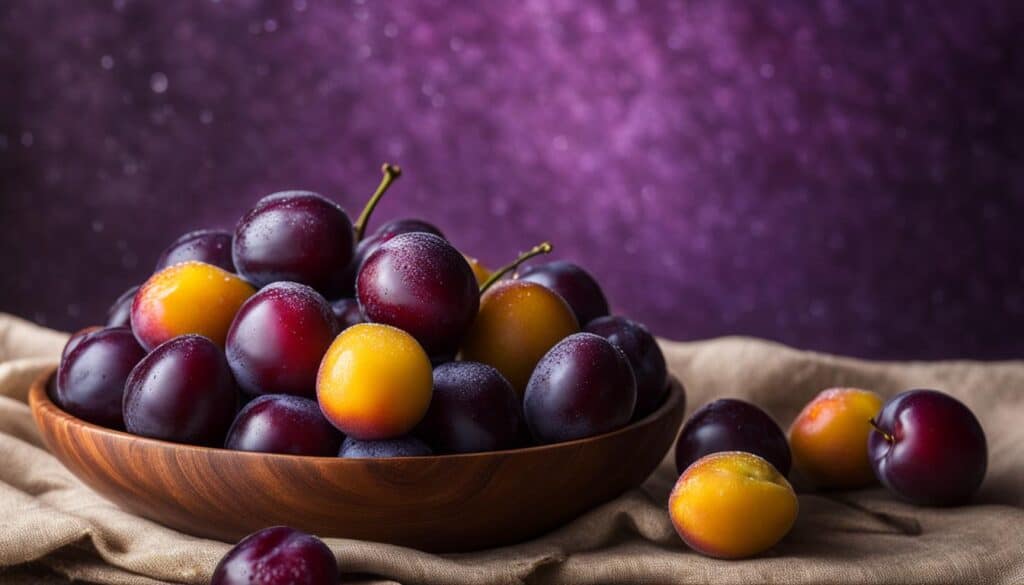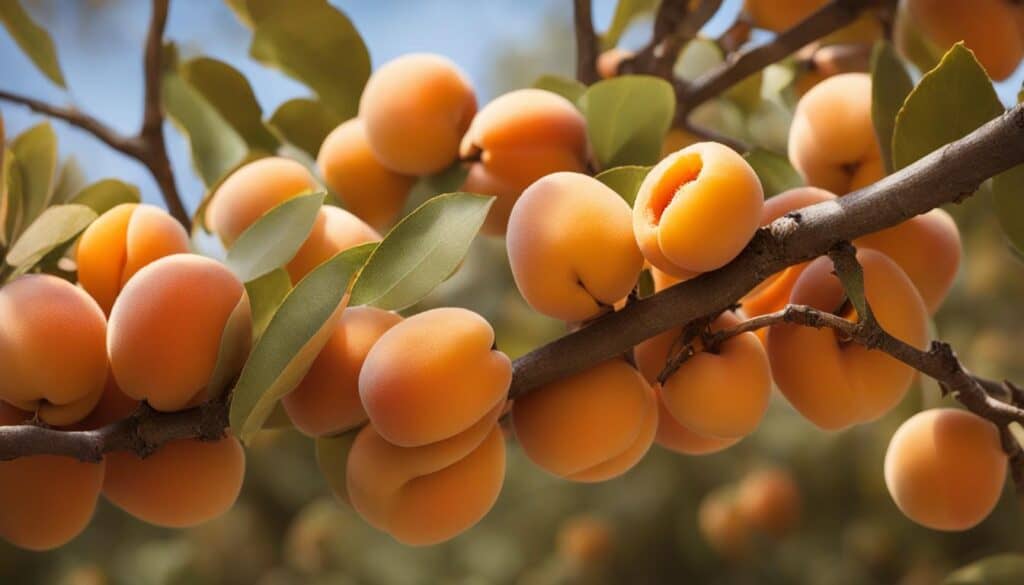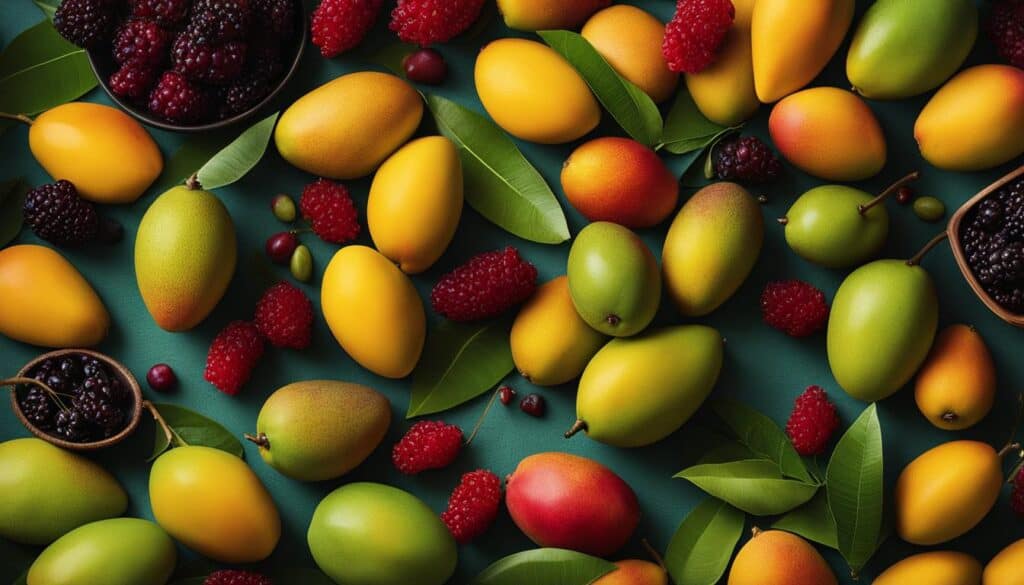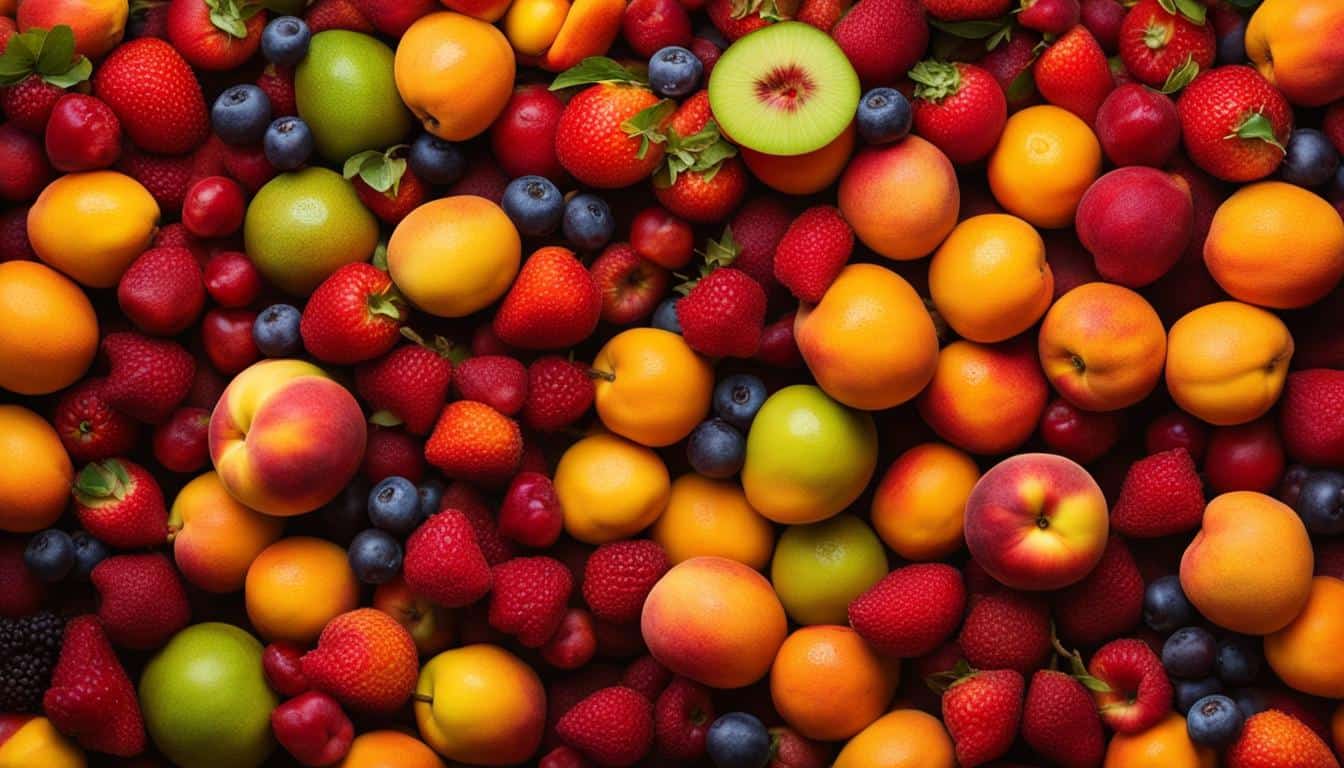Are you a fan of peaches and looking to explore other fruits with similar characteristics? Look no further! In this article, we will introduce you to a variety of fruit options that resemble peaches in taste, flavor, and texture. Whether you’re searching for a peach substitute or simply want to try something new, these fruits with peach-like characteristics are sure to delight your taste buds.
Key Takeaways:
- Stone fruits are a group of fruits that have a pit or stone in the center.
- Peaches, plums, nectarines, apricots, and cherries are common types of stone fruits.
- Other stone fruits include mangoes, mulberries, and olives.
- Coconuts and dates, while unconventional, are also considered stone fruits.
- Hybrid stone fruits like pluots, apriums, and peacotums offer unique flavors.
What are Stone Fruits?
Stone fruits, also known as drupes, are a group of fruits that have a pit or stone in the center. These fruits are characterized by their thin skins and can have either clingstone or freestone flesh. The pit or stone is surrounded by a fleshy outer area, making them visually distinct.
Stone fruits are highly seasonal and are picked at their peak of ripeness. They are known for their juicy and flavorful characteristics, making them a favorite among fruit enthusiasts. The term “stone fruit” refers to a variety of fruits, including peaches, plums, nectarines, apricots, and cherries.
The flesh of stone fruits can be either clingstone or freestone. Clingstone fruits have flesh that clings tightly to the pit, while freestone fruits have flesh that easily separates from the pit. The different varieties of stone fruits offer a diverse range of flavors, textures, and uses in various culinary creations.
In summary, stone fruits are a diverse group of fruits with thin skins and pits or stones in the center. They are characterized by their delicious and juicy flesh, which can be either clingstone or freestone. From peaches and plums to nectarines and cherries, stone fruits offer a wide variety of flavors and uses, making them a popular choice for both cooking and snacking.
Common Types of Stone Fruits
Stone fruits are a diverse group of fruits that offer a wide range of flavors, textures, and uses. Here are some of the most common types of stone fruits:
- Peaches: Known for their fuzzy skin and juicy flesh, peaches are a classic stone fruit that comes in different varieties, including yellow and white peaches.
- Plums: With a thin, smooth skin and juicy flesh, plums come in various colors such as red, black, and yellow.
- Nectarines: Similar to peaches but without the fuzz, nectarines have a smooth skin and a slightly firmer texture.
- Apricots: These smaller-sized stone fruits have a tart flavor and a creamy texture, making them perfect for making jam or enjoying fresh.
- Cherries: Available in both sour and sweet varieties, cherries offer a tart flavor and are great for snacking or using in desserts.
Each of these stone fruits has its own unique characteristics and can be used in a variety of culinary creations. Whether you’re baking a pie, making a salad, or simply enjoying them fresh, stone fruits add a burst of flavor to any dish.

Table: Comparison of Common Types of Stone Fruits
| Stone Fruit | Characteristics | Flavor | Best Uses |
|---|---|---|---|
| Peaches | Fuzzy skin, juicy flesh | Sweet and tangy | Grilling, baking, or enjoying fresh |
| Plums | Thin smooth skin, juicy flesh | Sweet and slightly tart | Raw consumption, salads, or cooking |
| Nectarines | Smooth skin, firmer texture | Sweet and slightly tangy | Interchangeable with peaches in cooking or enjoying fresh |
| Apricots | Smaller size, creamy texture | Tart and slightly sweet | Jam-making, baking, or eating fresh |
| Cherries | Various colors, juicy flesh | Sour or sweet | Snacking, desserts, or incorporating into recipes |
As you can see, each type of stone fruit brings its own unique flavor and texture to the table. From the sweetness of peaches and nectarines to the tartness of plums and cherries, there’s a stone fruit for every taste preference.
Peaches: The Classic Stone Fruit
Peaches are one of the most popular stone fruits, known for their fuzzy skin and juicy flesh. They come in different varieties, including yellow and white peaches, as well as clingstone and freestone varieties. Peaches are great for grilling, adding to cobblers and pies, or simply enjoying fresh. They are in season from midsummer to the beginning of fall.
Peach Varieties
Peaches come in a variety of types, each with its own unique characteristics:
- Yellow Peaches: These peaches have a golden skin and a sweet, juicy flesh. They are the most common variety found in supermarkets.
- White Peaches: White peaches have a pale yellow skin and a slightly less acidic flavor than yellow peaches. They are known for their sweet and floral taste.
Furthermore, peaches can be classified into clingstone and freestone varieties based on how easily the flesh separates from the stone:
- Clingstone Peaches: In clingstone peaches, the flesh sticks to the stone, making them more difficult to separate.
- Freestone Peaches: Freestone peaches have flesh that easily separates from the stone, making them preferable for eating fresh or for culinary purposes.
Table: Comparison of Peach Varieties
| Peach Variety | Flavor | Texture |
|---|---|---|
| Yellow Peaches | Sweet and juicy | Soft and juicy |
| White Peaches | Sweet and floral | Tender and succulent |
Peaches are a versatile fruit that can be enjoyed in a variety of ways. Whether you’re baking a peach pie, grilling them for a summer barbecue, or simply biting into a juicy peach, the sweet and refreshing flavor of peaches is sure to satisfy your taste buds.
Plums: A Juicy and Versatile Fruit

Plums are a delectable stone fruit known for their thin smooth skin and juicy flesh. They come in a variety of colors including red, black, and yellow, each with its own unique flavor profile. Plums have a long growing season, typically from spring through early fall, making them readily available for consumption and culinary experimentation.
With their juicy and succulent texture, plums are perfect for eating fresh or incorporating into a wide range of recipes. They can be enjoyed as a refreshing snack, added to salads for a burst of flavor, or used in both sweet and savory dishes. From plum tarts and pies to plum-infused sauces and dressings, the versatility of plums knows no bounds.
| Plum Variety | Color | Flavor |
|---|---|---|
| Red Plums | Red | Sweet and tangy |
| Black Plums | Black | Rich and sweet |
| Yellow Plums | Yellow | Mild and slightly tart |
Plums are also packed with nutrients, including vitamins A and C, as well as dietary fiber. They provide a natural sweetness while being low in calories, making them a healthy and satisfying choice for those looking to indulge their sweet tooth without the guilt.
In conclusion, plums are a delightful stone fruit with a thin smooth skin, juicy flesh, and a range of vibrant colors and flavors. Whether enjoyed fresh, incorporated into various recipes, or showcased in a beautiful fruit salad, plums are sure to add a burst of flavor and color to any culinary creation.
Nectarines: Peaches Without the Fuzz
Nectarines are a type of stone fruit that closely resembles peaches but without the fuzzy skin. They have a smooth skin that is easy to bite into, eliminating the need for peeling. Nectarines also have a slightly firmer texture compared to peaches, making them perfect for slicing and adding to salads or using as a topping for desserts.
Similar to peaches, nectarines can be categorized as freestone, clingstone, or semi-freestone. Freestone nectarines have flesh that easily separates from the pit, making them ideal for eating fresh or using in recipes. Clingstone nectarines have flesh that clings to the pit, which can be a bit more challenging to remove. Semi-freestone nectarines have a combination of both characteristics.
Whether you’re enjoying a nectarine to satisfy your sweet tooth or incorporating it into your favorite recipes, this peach-like fruit offers a delightful burst of flavor and a smooth, juicy texture. With their versatility and refreshing taste, nectarines are a delicious addition to your summer fruit selection.
Apricots: Tart and Creamy
Apricots are a smaller-sized stone fruit that resemble peaches and nectarines. Despite their smaller size, apricots pack a punch of flavor with their tart taste. The creamy texture of the apricot flesh adds a delightful contrast to the tangy flavor. These peach-like fruits are a popular choice for making jam or drying, as their skin is rich in pectin. Whether enjoyed fresh when ripe or incorporated into various culinary creations, apricots bring a unique and tasty element to any dish.

Apricots are in season during the summer months, making them a refreshing treat during the warm weather. Their versatility allows them to be used in both sweet and savory recipes. From apricot tarts and pies to savory dishes like apricot-glazed chicken, the possibilities are endless. The combination of the tart flavor of apricots and the richness of their creamy texture adds depth and complexity to any dish they are featured in.
Apricot Recipes:
- Apricot and almond tart
- Grilled apricots with honey and mascarpone
- Apricot-glazed chicken
“Apricots bring a burst of tangy flavor and a creamy texture to every bite. They’re the perfect fruit for both sweet and savory recipes.”
| Apricot Variety | Size | Flavor | Best Used For |
|---|---|---|---|
| Blenheim | Medium | Tart and sweet | Jams, tarts, pies |
| Hargrand | Large | Sweet | Snacking, salads, grilling |
| Moorpark | Medium to large | Sweet and tangy | Baking, preserves, drying |
Apricots are not only delicious but also a great source of essential nutrients. They are rich in vitamins A and C, as well as dietary fiber. These nutrients contribute to maintaining a healthy immune system and promoting good digestive health. With their unique combination of flavors and health benefits, apricots are a fantastic addition to any diet.
Cherries: The Delightful Spring Stone Fruit
Cherries are a delightful stone fruit that brings a burst of flavor to the spring season. With their vibrant colors and juicy texture, cherries are a favorite for both snacking and incorporating into a wide variety of dishes. This versatile fruit comes in both sour and sweet varieties, each offering its own unique taste experience.
Sour cherries, also known as tart cherries, have a tangy and slightly acidic flavor. They are commonly used in baking, particularly in pies, tarts, and jams. The tartness of these cherries adds a refreshing contrast to sweet desserts, making them a popular choice among pastry chefs and home bakers alike.
Sweet cherries, on the other hand, have a lusciously sweet flavor that is perfect for snacking. These cherries are best enjoyed fresh and are often eaten straight from the tree. Their juicy flesh and rich taste make them a delightful treat for both kids and adults.
“Cherries are nature’s sweet gems, bursting with flavor and offering a delightful snacking experience. Whether you prefer the tartness of sour cherries or the sweetness of their counterparts, cherries are a true springtime delight.” – Cherry lover
Cherries are not only delicious but also packed with nutritional benefits. They are a good source of vitamins A and C, antioxidants, and fiber. These nutrients contribute to overall health and well-being, making cherries a guilt-free indulgence.
| Type of Cherry | Flavor | Common Uses |
|---|---|---|
| Sour cherries | Tart and acidic | Baking, jams, sauces |
| Sweet cherries | Lusciously sweet | Snacking, salads, desserts |
Whether you enjoy them fresh, baked into a pie, or added to a savory dish, cherries are a delightful addition to any springtime menu. These stone fruits offer a burst of flavor and a touch of sweetness that is sure to brighten up your day.

Mangoes, Mulberries, and Olives: A Comparison
| Stone Fruit | Flavor | Uses |
|---|---|---|
| Mangoes | Tropical, sweet, and juicy | Eaten fresh, added to salads, used in smoothies, sauces, and desserts |
| Mulberries | Sweet and slightly tart | Used in jams, pies, tarts, desserts, and infused in drinks |
| Olives | Savory and briny | Used in salads, pizzas, pasta dishes, tapenades, and as a garnish |
Each of these stone fruits brings its own unique characteristics to the table. Mangoes add a tropical touch to dishes, mulberries provide a sweet-tart flavor, and olives offer a savory element. Experimenting with these diverse stone fruits can open up a whole new world of flavors and culinary possibilities.
Coconut and Dates: Unconventional Stone Fruits
While stone fruits are typically associated with fruits like peaches, plums, and cherries, there are a few unconventional fruits that also fall into this category. Two such examples are coconuts and dates, both of which have unique characteristics that set them apart from traditional stone fruits.
Coconuts: A Tropical Delight
Coconuts are often associated with tropical locales and are known for their distinct three-layer structure. The hard outer layer, or shell, protects the inner meat, known as the endosperm, which is surrounded by a liquid known as coconut water. Coconuts have a rich, creamy texture and a sweet, nutty flavor that adds depth to both sweet and savory dishes. They can be grated, toasted, or used in the form of coconut milk or oil to enhance the flavors of various recipes.
Dates: Nature’s Sweet Treat
Dates are the fruit of the date palm tree and are known for their chewy texture and sweet flavor. These small, oval-shaped fruits are high in natural sugars and are often enjoyed as a healthy and satisfying snack. Dates can also be used in baking, adding natural sweetness to desserts and baked goods. Their unique flavor profile makes them a versatile ingredient in both sweet and savory dishes.
| Coconuts | Dates |
|---|---|
| Tropical fruit | High in natural sugars |
| Rich, creamy texture | Chewy texture |
| Sweet, nutty flavor | Naturally sweet flavor |
| Versatile in cooking | Used in both sweet and savory dishes |
While coconuts and dates may not be the first fruits that come to mind when thinking of stone fruits, they share the characteristic pit or stone that qualifies them for this category. Their unique flavors and textures make them a delightful addition to any culinary repertoire.
Hybrid Stone Fruits: Pluots, Apriums, and Peacotums
While stone fruits like peaches, plums, and apricots are well-known and loved, there are also some unique hybrid varieties that offer even more flavors to explore. Pluots, apriums, and peacotums are examples of these fascinating crossbreeds that combine the best characteristics of different stone fruits.
Pluots, also known as plumcots, are a cross between plums and apricots. They have a deep, rich flavor that leans more towards the plum side, with a slightly tart and sweet taste. Pluots come in various colors and can range from very sweet to tangy. They are often enjoyed fresh or used in desserts and jams.
Apriums, on the other hand, are a combination of apricots and plums. They have a unique flavor profile that balances the sweetness of apricots with the slight tartness of plums. Apriums have a smooth texture and are great for snacking, baking, or adding to salads.
Peacotums are the result of crossing peaches, apricots, and plums. They offer a complex flavor that combines the sweetness of peaches, the tartness of apricots, and the richness of plums. Peacotums have a juicy and aromatic flesh that can be enjoyed fresh or used in a variety of culinary creations.
| Hybrid Stone Fruit | Taste | Usage |
|---|---|---|
| Pluots | Sweet with a hint of tartness | Enjoyed fresh, desserts, jams |
| Apriums | Balance of sweetness and tartness | Snacking, baking, salads |
| Peacotums | Complex flavor combining sweetness, tartness, and richness | Enjoyed fresh, versatile in cooking |
These hybrid stone fruits offer a unique and exciting twist on traditional stone fruits. They provide a delightful combination of flavors that can elevate your culinary creations and introduce a new level of enjoyment to your fruit-eating experience. Whether you choose pluots, apriums, or peacotums, you’re sure to discover a truly one-of-a-kind taste sensation.
Conclusion
In conclusion, stone fruits are a delightful and diverse group of fruits that offer a wide range of flavors, textures, and culinary uses. Whether you’re a fan of the classic peaches and plums or enjoy exploring more unique options like mangoes and olives, there is a stone fruit for everyone’s taste.
These fruits can be enjoyed fresh, added to various dishes, or used in jams and jellies. Their versatility makes them a great addition to any diet, providing not only delicious flavors but also essential nutrients.
So why not expand your fruit repertoire and explore the world of stone fruits? From the juicy sweetness of a ripe peach to the tanginess of a fresh plum, there are so many flavors waiting to be discovered. Incorporate these fruits into your favorite recipes, experiment with new flavors, and find your new favorites today!
FAQ
What are stone fruits?
Stone fruits, also known as drupes, are a group of fruits that have a pit or stone in the center.
What is the difference between clingstone and freestone stone fruits?
Clingstone stone fruits have flesh that clings to the stone, while freestone stone fruits have flesh that easily separates from the stone.
What are some common types of stone fruits?
Some common types of stone fruits include peaches, plums, nectarines, apricots, and cherries.
How can I use stone fruits in recipes?
Stone fruits can be used in a variety of recipes, including grilling, adding to cobblers and pies, or simply enjoying fresh.
When are peaches in season?
Peaches are in season from midsummer to the beginning of fall.
What can I do with plums?
Plums can be eaten raw, added to salads, or used in various recipes, both sweet and savory.
What is the difference between peaches and nectarines?
Nectarines are similar to peaches but have a smooth skin and a slightly firmer texture.
Can I substitute peaches with nectarines in recipes?
Yes, nectarines can be used interchangeably with peaches in cooking and baking.
How can I use apricots?
Apricots are great for making jam or drying, as well as baking or enjoying fresh when ripe.
When are cherries in season?
Cherries are in season during the summer months.
Are mangoes considered stone fruits?
Yes, mangoes are considered stone fruits, despite not having a large pit.
Can I use olives in cooking?
Yes, olives, which are also considered stone fruits, can be used in various culinary creations.
What are some hybrid stone fruits?
Some hybrid stone fruits include pluots, apriums, and peacotums, which offer unique flavors and can be used in a variety of dishes.





Leave a Reply